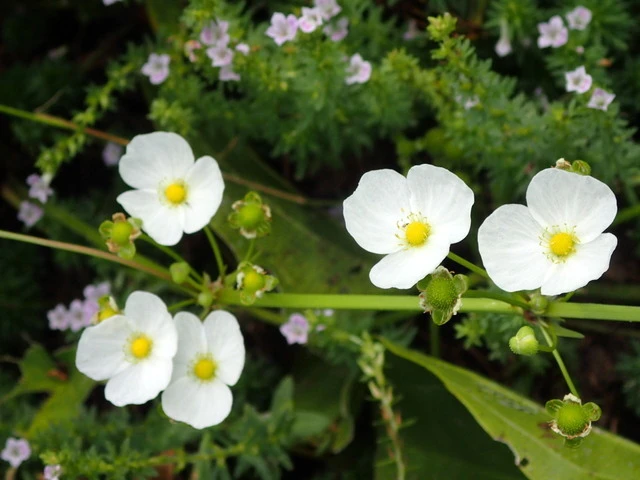Creeping Burhead
(Aquarius cordifolius)
Creeping Burhead (Aquarius cordifolius)
/
/

mfeaver
CC BY 4.0
Image By:
mfeaver
Recorded By:
Copyright:
CC BY 4.0
Copyright Notice:
Photo by: mfeaver | License Type: CC BY 4.0 | License URL: http://creativecommons.org/licenses/by/4.0/ | Rights Holder: mfeaver | Publisher: iNaturalist | Date Created: 2019-09-28T11:54:08-07:00 |

























Estimated Native Range
Climate Requirements for Grand Rapids, Michigan
| This Plant | Your Site | Plant Suitability for Your Location | ||
|---|---|---|---|---|
| • Precipitation | 50" - 60" | 36" | Aquatic | Aquatic |
| • High Temp. | 89°F - 94°F | 84°F | Your summer temperatures are normal for this plant. | Excellent |
| • Low Temp. | 25°F - 56°F | 16°F | Your winter temperatures are normal for this plant | Excellent |
This plant should grow well at your location with about N inches per year (Y minutes per month) of irrigation.
Summary
Aquarius cordifolius, commonly known as Creeping Burhead, is a perennial herb that is native to the southeastern United States, Mexico, and the Caribbean islands, extending south to Venezuela and Colombia. It can also be found in Central and South America, as far south as Paraguay. It thrives in alpine meadows, woodlands, and areas along streams at high elevations. This species is known for its distinctive blue and white flowers that bloom in late spring to early summer, which are highly attractive to hummingbirds and butterflies. The flowers are quite showy, with a unique spurred shape, and they can add a touch of elegance to any garden setting.
Colorado Blue Columbine typically grows to a height of 1.5-2 feet (0.45-0.6 meters) and spreads 1-2 feet (0.3-0.6 meters). Its foliage is delicate and green, forming a beautiful backdrop for the striking flowers. The plant is valued for its ease of maintenance and its ability to attract pollinators. It is often used in wildflower gardens, as part of border plantings, or in naturalized areas. For optimal growth, it prefers well-drained, moist soils and can tolerate a range of light conditions from full sun to part shade. While it is generally disease-resistant, it can be susceptible to leaf miners and powdery mildew. It is also important to note that Colorado Blue Columbine can hybridize with other Aquilegia species, which can be a concern for maintaining the genetic purity of wild populations.CC BY-SA 4.0
Colorado Blue Columbine typically grows to a height of 1.5-2 feet (0.45-0.6 meters) and spreads 1-2 feet (0.3-0.6 meters). Its foliage is delicate and green, forming a beautiful backdrop for the striking flowers. The plant is valued for its ease of maintenance and its ability to attract pollinators. It is often used in wildflower gardens, as part of border plantings, or in naturalized areas. For optimal growth, it prefers well-drained, moist soils and can tolerate a range of light conditions from full sun to part shade. While it is generally disease-resistant, it can be susceptible to leaf miners and powdery mildew. It is also important to note that Colorado Blue Columbine can hybridize with other Aquilegia species, which can be a concern for maintaining the genetic purity of wild populations.CC BY-SA 4.0
Plant Description
- Plant Type:
- Height: 0.5-1.5 feet
- Width: 0.5-1 feet
- Growth Rate: Moderate
- Flower Color: White
- Flowering Season: Spring
- Leaf Retention: Semi-deciduous
Growth Requirements
- Sun: Part Shade, Full Shade
- Water: Medium
- Drainage: Medium, Slow
Common Uses
Bird Garden, Butterfly Garden, Hummingbird Garden, Low Maintenance, Water Garden
Natural Habitat
Native to alpine meadows, woodlands, and areas along streams
Other Names
Common Names: Lance-Leaf Burhead , Radican Sword
Scientific Names: Aquarius cordifolius , Alisma cordifolium , Damasonium cordifolium , Echinodorus cordifolius , Echinodorus cordifolius subsp. cordifolius , Echinodorus cordifolius subsp. fluitans , Echinodorus fluitans , Echinodorus ovalis , Echinodorus radicans , Echinodorus radicans
GBIF Accepted Name: Aquarius cordifolius